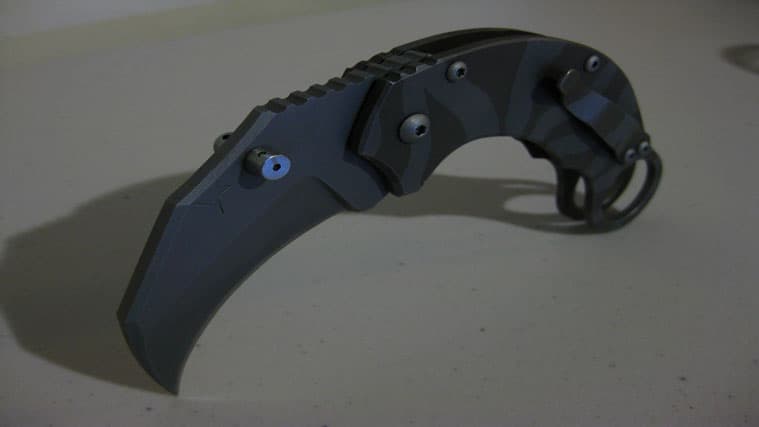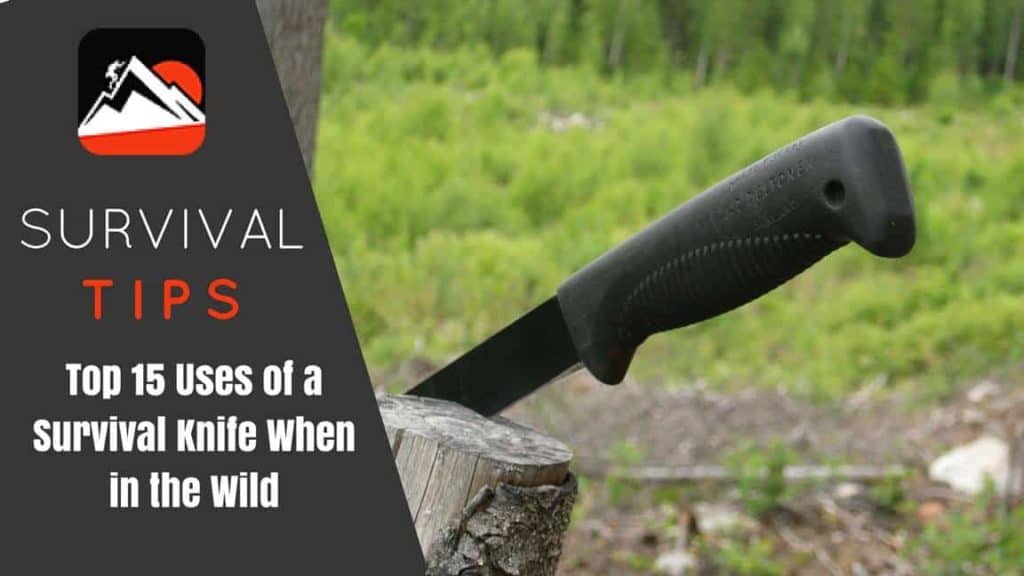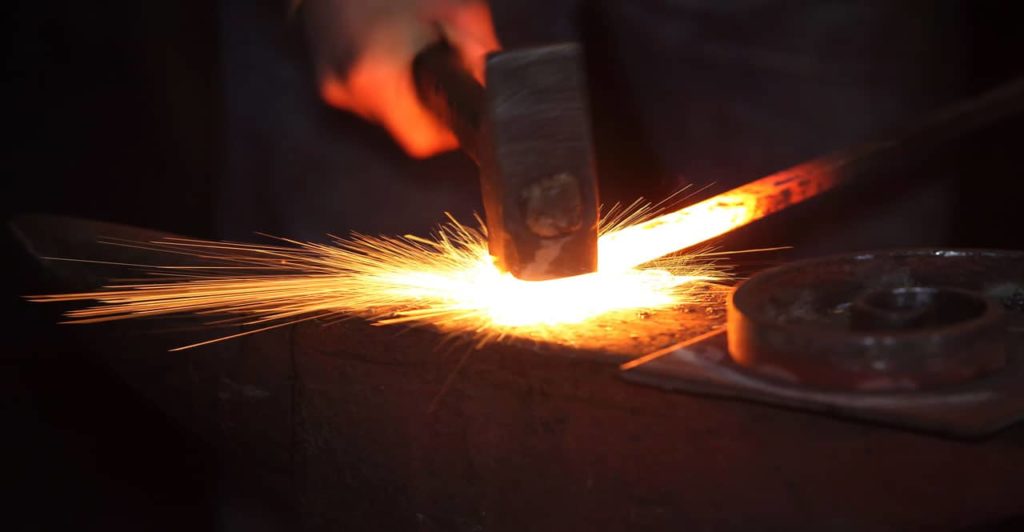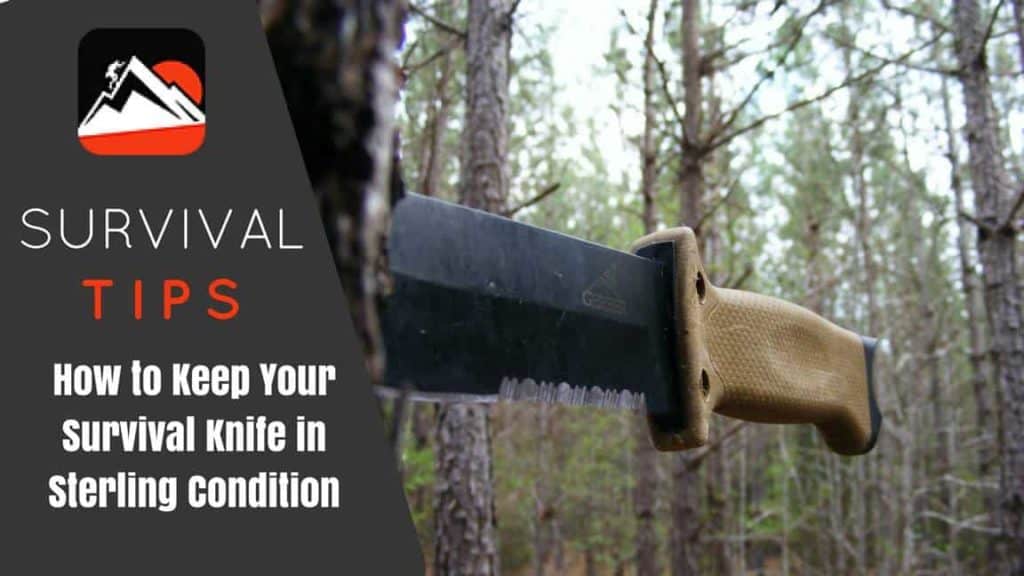Contents
Just like the Malaysian Khukuri with its sharply angled back and recurved edge and, the Indonesian Kris with its serpentine, double-edged, blade, the Sumatran Krambit is one of those ethnic knife designs that are easily recognizable with a single glance. Believed to have originated among the Minangkabau people of West Sumatra, The Karambit is, according to the folklore, believed to have been inspired by the claws of a Tiger. However, despite its martial appearance, the Karambit was originally designed as an agricultural tool for raking roots, gather threshing and, planting rice. But, as it evolved into a weapon, the blade became more curved in order to maximize its cutting potential. Thus, today it is one of the main weapons of Silat and is commonly used in the Filipino martial art of Kali.
KARAMBIT BUYER’S GUIDE
When it comes to Karambits, the first thing that you need to be aware of is that, while you theoretically could use a traditional Karambit as an every-day-carry utility tool, Karambits were specifically designed to be used as both defensive and offensive battlefield weapons. Therefore, they tend to be viewed as weapons by other people regardless of your purpose for carrying one.
Also, you should be aware that while all Karambits have a similar, very distinctive, blade and handle design, not all Karambit have the same exact design. Thus, in addition to both fixed blade and folding Karambits, both blade and handle designs differ from manufacturer to manufacturer.
However, when choosing your Karambit from among the many different designs on the market today, there are certain specifications that you should be aware of because they not only pertain to both fixed blade and folding knives, by understanding them and what they mean, they will help you to choose the Karambit that best suits your individual intent and purpose for it. However, if you are not already familiar with knife design, then attempting to determine the meaning of the various knife specifications can be confusing to say the least. So, the very first specification that you should take a look at is the type of steel that the blade is made from because the blade is the heart and soul of a knife and thus, a good choice of blade steels will get you a knife that performs like you want it to while a poor choice in blade steels will get you a knife who’ performance you will not be happy with. Of course, in addition to the type of steel the blade is made from, it is also helpful to know its Rockwell Hardness because this will tell you how tough the steel is and how well it will hold an edge. In addition, in the case of both fixed blade and folding Karambits, the length of the handle should be considered since one that is too short will not provide a comfortable or secure grip while one that is too long will feel awkward and will not perform well. Furthermore, blade length is another important factor that should be considered when choosing a Karambit because the length of the blade affects both its reach and its mobility. Last, when choosing a Karambit, you will also need to decide whether you prefer a blade with a plain edge, a partially serrated edge, or a fully serrated edge since plain edges do not lacerate as well as serrated edges do but, plain edges are also relatively easy to sharpen whereas, serrated edges are very difficult to sharpen and require a round, ceramic, sharpening rod of the correct diameter. So, below you will find information that explains each of these aspects to help you choose the Karambit that best suits you.
- Blade steels – As I mentioned above, the first specification that you should look at when purchasing a Karambit is the type of steel that the blade is made from. For instance, when choosing a fixed blade Karambit, some users might prefer a high carbon plain tool steel rather than a stainless steel because plain tool steels are both tougher and easier to sharpen than stainless steels are. However, stainless steels are far more resistant to corrosion and thus, they require less care and maintenance. Thus, a fixed blade Karambit made from either a plain tool steel or a stainless steel can be a good choice. On the other hand, when choosing a folding Karambit, then choosing one with a blade made from a stainless steel rather than a high carbon plain tool steel is a wise decision because any knife carried in user’s pocket is subject to constant perspiration from the user’s body. Thus, when purchasing a Karambit, the type of steel the blade is made from is the single most important factor to consider.
- Rockwell Hardness – Also as mentioned above, in addition to the type of steel a knife blade is made from, the blade’s Rockwell Hardness is another important factor that should be considered right along with the type of steel the blade is made from because it will not only determine how easy or difficult the blade is to sharpen, it will also determine how well it will hold an edge. Therefore, you need to be aware that the Rockwell C scale (designated HRC) is commonly used to measure the hardness of blade steels and, the lower the Rockwell Hardness is, the tougher the steel will be and the easier it will be to sharpen while, the higher the Rockwell Hardness is, the better the blade will hold an edge but, the more difficult it will be to sharpen. Thus, when choosing a Karambit, blade steels with a Rockwell Hardness of 55 HRC to 60 HRC are a good choice.
- Blade Length – When choosing a Karambit, you need to keep in mind the fact that most fixed blade Karambits are specifically designed to serve as both offensive and defensive fighting knives while many folding Karambit designs are designed to serve as every-day-carry utility knives. Therefore, blade length is another important factor that you should carefully consider when choosing either a fixed blade or a folding Karambit because the length of the blade will affect both the blade’s reach and its mobility, as well as its utility.
- Plain vs. Serrated Cutting Edges – Of course, in addition to blade length, the type of cutting edge that you choose also affects the blade’s performance. For instance, when choosing either a fixed blade or a folding Karambit, you will need to decide between a blade with a plain edge, a partially serrated edge or, a fully serrated edge. But, keep in mind that both types have both advantages and disadvantages. For instance, plain edges provide a smoother cut and are relatively easy to sharpen but, they may not lacerate as easily or as deeply as partially serrated edges. On the other hand, partially serrated edges will lacerate more deeply and do a much better job of cutting both string, rope, and plastic ties but, they are notoriously difficult to sharpen because they require a round ceramic sharpening rod of the correct diameter to match the serrations in order to maintain their edge.
- Opening Mechanisms – Furthermore, you should be aware that all folding knives employ one of three different types of opening mechanisms consisting of Manual Opening Mechanisms, Assisted Opening Mechanisms and, Automatic Opening Mechanisms. Consequently, a Manual Opening Mechanism requires the user to use a nail nick, a thumb stud, or a thumb hole to manually rotate the blade from the closed position to the open position. But, you should also be aware that knives with nail nicks require a person to use two hands to open the blade or blades whereas, knives with either thumb studs or thumb holes enable the user to open the blade with a single hand. Then, there are assisted opening mechanisms which use a coil spring to assist the user in opening the blade. Thus, to open an assisted opening knife, the user simply applies pressure to either a thumb stud or a thumb hole to manually open the blade approximately 30 degrees and then, the coil spring will take over and automatically open the blade the rest of the way. So, while Manual Opening mechanisms are the most common type of opening mechanism featured on folding knives today, Assisted Opening mechanisms are also becoming popular because they are very convenient.
- Locking Mechanisms – When looking at folding knives on the Web, you will likely quickly notice that there seem to be nearly as many different types of folding knife locking mechanisms as there are folding knife manufacturers. Therefore, in order to make understanding this myriad of knife blade locking mechanisms a bit easier, the first step is to divide them into two separate categories that consist of those such as Liner Locks and Piston Locks which enable a user to unlock and close the blade with a single hand and, others such as Mid Locks and Back Locks that require the user to engage both hands to unlock and close the blade. Then, when learning about the advantages and disadvantages of each individual type of knife blade locking mechanism, don’t allow yourself to be misled by claims of lock strength because very little stress is actually placed on a locking mechanism when performing every day cutting tasks with a folding knife. Instead, you should concentrate on how well any given locking mechanism will handle wear and whether or not it will automatically adjust to compensate for it in order to keep the lock tight.










You might find interesting to read our best kukri machetes article.
THE TOP 7 FIXED BLADE AND FOLDING KARAMBITS
Because there are so many different knife manufactures in the market today who produce so many different designs, choosing a single Karambit from all of those on the market can be a confusing task. Therefore, it should be noted that most fixed blade Karambits are specifically designed to be dedicated fighting knives while many folding Karambit knives are hybrid designs that actually serve as useful every day carry knives for people who like the Karambit design but prefer a more moderate utility knife. Therefore, with this in mind, I have listed below what I feel are the top seven fixed blade and folding Karambits to help make the task of choosing a Karambit easier for you.
1. COLD STEEL “STEEL TIGER” FIXED BLADE KARAMBIT
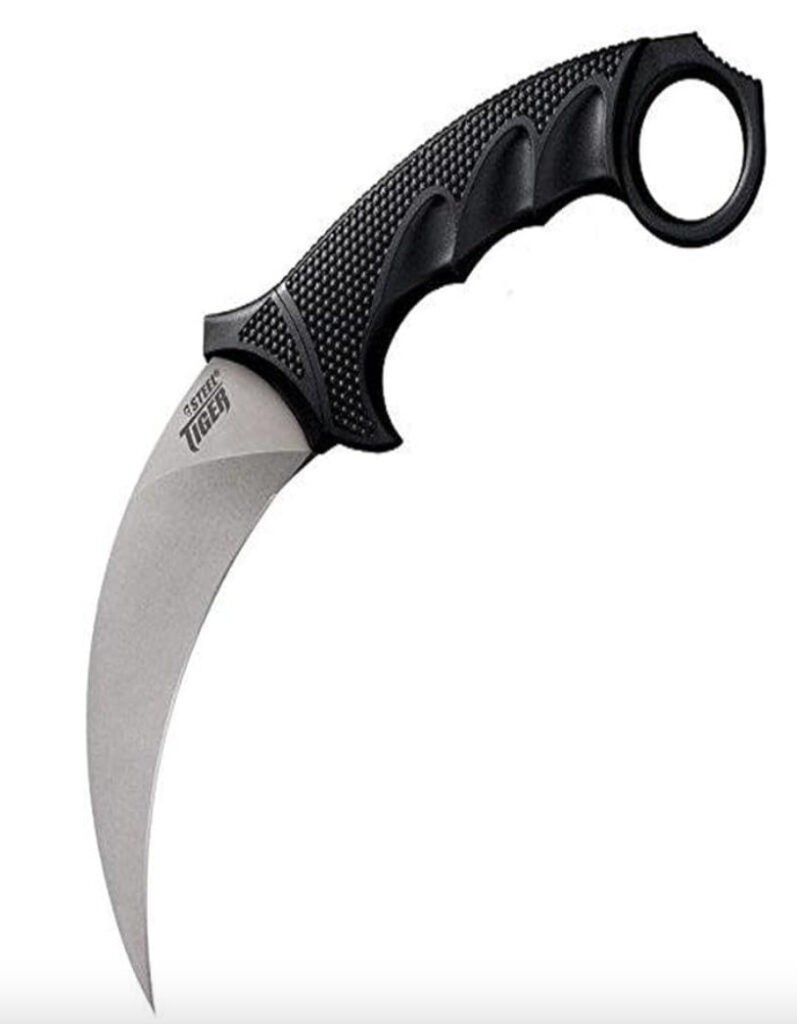
The Steel Tiger fixed blade Karambit by Cold Steel features an overall length of 8.75 inches with a 4.75-inch blade and a weight of 5 ounces. In addition, it also features a Karambit style, single edge, drop point, blade design made from AUS-8 (which is a Japanese, high carbon, Stainless Steel) with an unknown Rockwell Hardness and a single plain edge with a flat grind and stonewashed finish. In addition, it also features a hidden tang with a black, Griv-Ex w/Overmolded Kray-Ex (aka Grivory with Thermo Formed Rubber), handle and a large pommel ring. Plus, it includes a Secure-Ex (hard, molded, nylon) belt sheath.
Pros
- (+) Extra long blade
- (+) High-quality stainless blade steel
- (+) Comfortable and cushy handle
Cons
- (-) Not easily concealed
2. SOG GAMBIT FIXED BLADE KARAMBIT
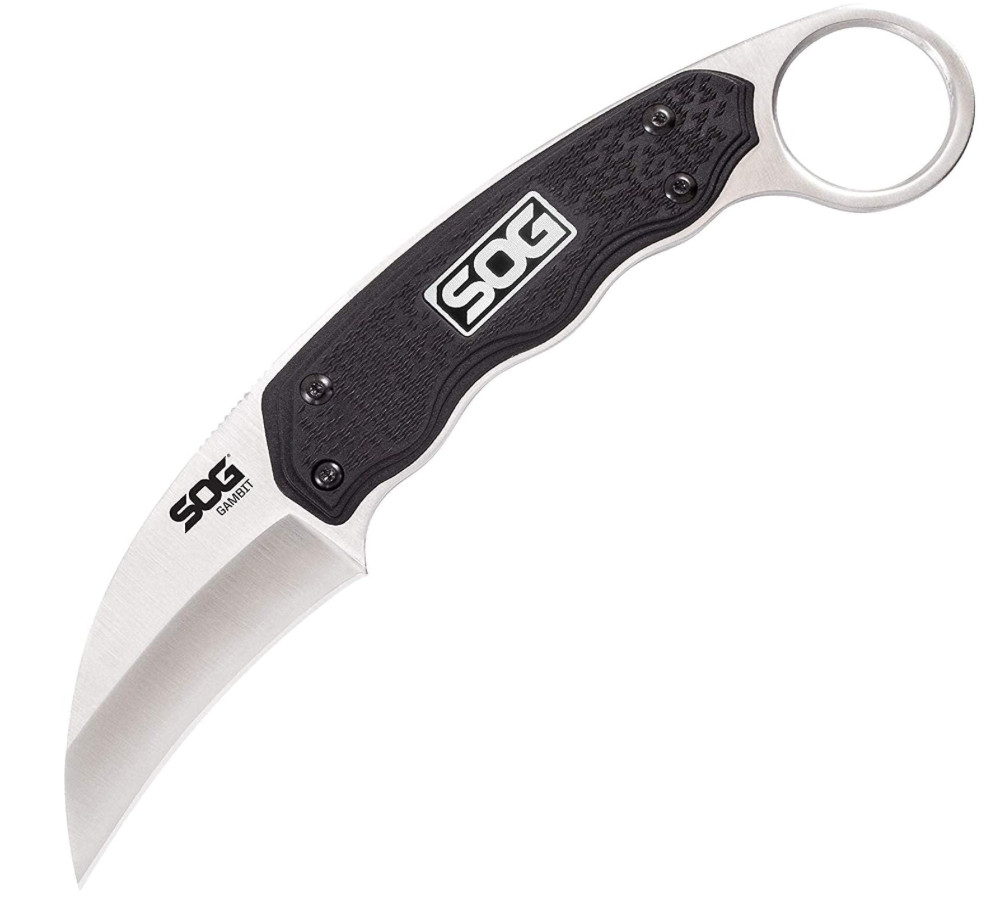
The SOG Gambit fixed blade Karambit is a relatively small knife that features an overall length of 7.3 inches and a blade length of 2.58 inches with a weight of 2.8 ounces. In addition, it also features a Karambit style, single edge, drop point, blade design made from 7Cr17MoV (which is a Chinese, high carbon, Stainless Steel) with Rockwell Hardness of 54-58 and a single plain edge with a hollow grind and satin finish. In addition, it also features an ergonomic handle design with a full tang and black, Glass Reinforced Nylon, handle scales and a large pommel ring. Plus, it includes a hard, molded, nylon belt sheath.
Pros
- (+) Short blade
- (+) Hollow ground blade
- (+) Extra lightweight
Cons
- (-) Extra Short blade
- (-) Less than optimal blade steel
Check out our suggested parang machetes article.
3. BOKER MAGNUM SPIKE FIXED BLADE KARAMBIT
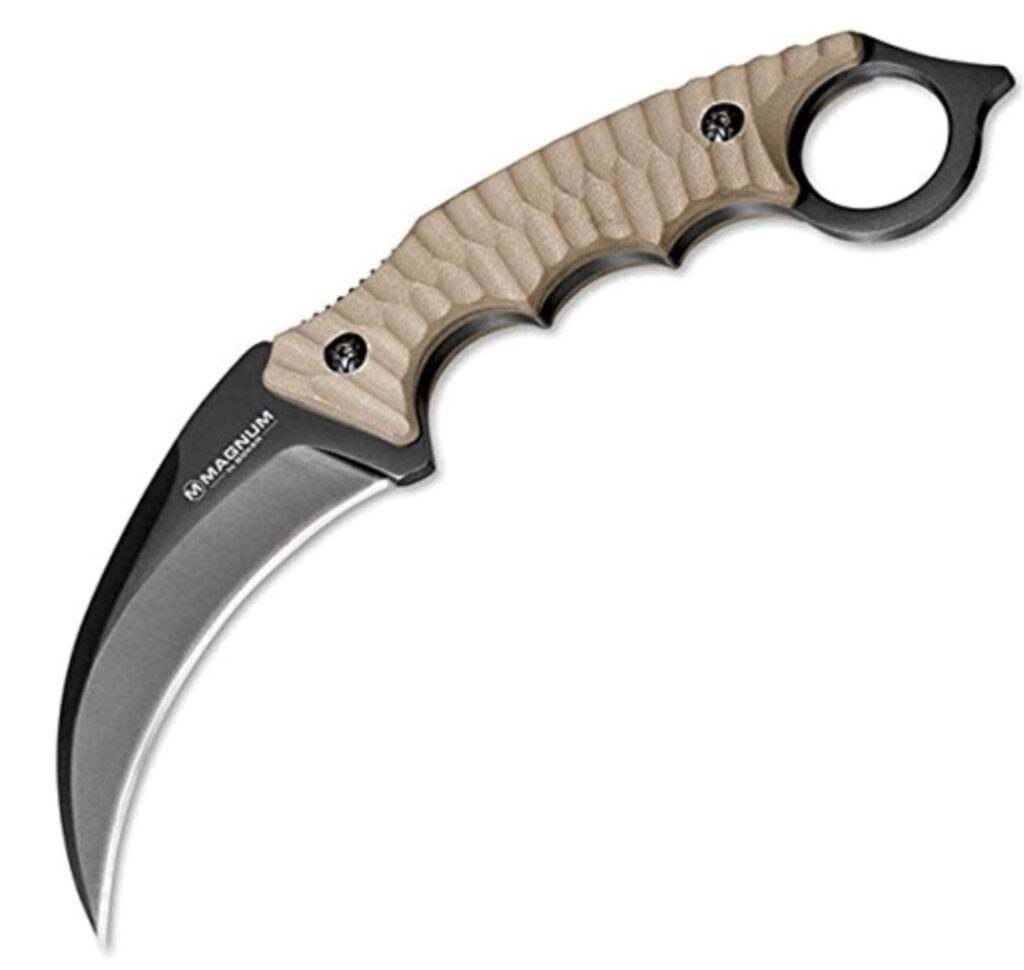
The Boker Magnum Spike fixed blade Karambit is a nicely designed and very well constructed fixed blade knife that features an overall length of 8.3 inches with a 4-inch blade and a weight of 7.5 ounces. In addition, it also features a Karambit style, single edge, drop point, blade design with a false edge made from 440A (which is an American, high carbon, Stainless Steel) with Rockwell Hardness of 56 and a plain edge with a hollow grind and a matte black finish. In addition, it also features an ergonomic handle design with a full tang and sand colored G10 handle scales and a large pommel ring with a spike for additional functionality. Plus, it includes a hard, molded, nylon belt sheath.
Pros
- (+) Graceful design
- (+) Good choice of blade steels
- (+) Good choice of handle materials
Cons
- (-) Not easily concealed
4. SCHRADE SCH112 FIXED BLADE KARAMBIT
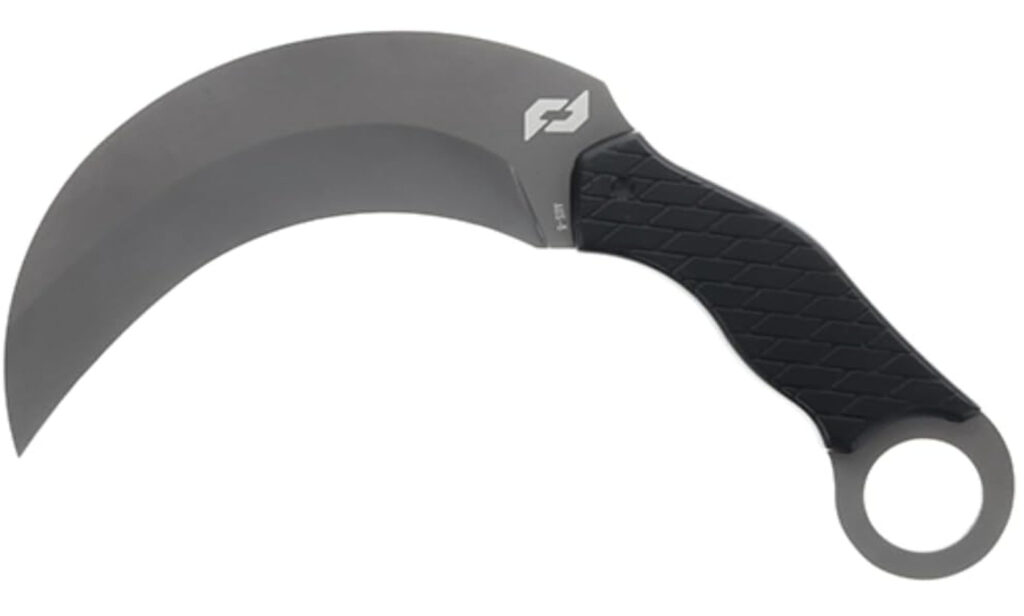
The Schrade model SCH112 fixed blade Karambit is an elegant, modern, version of the classic knife design that features an overall length of 8.39 inches with a 5.21-inch blade and a weight of 8.2 ounces. In addition, it also features a Karambit style, double edge, drop point, blade design made from 8Cr13MoV (which is a Chinese, high carbon, Stainless Steel) with an unknown Rockwell Hardness and plain edges with hollow grinds and a matte black finish. In addition, it also features an ergonomic handle design with a full tang and a black, Thermo Plastic Rubber, overmolded handle combined with a large pommel ring. Plus, it includes a hard, molded, nylon belt sheath.
Pros
- (+) Stainless blade steel
- (+) Double edge blade
- (+) Handle provides a positive grip
Cons
- (-) Long blade can interfere with some moves
- (-) Somewhat heavy
We also suggest checking out our article about the best Cold Steel machetes by clicking here.
5. COLD STEEL TIGER CLAW FOLDING KARAMBIT
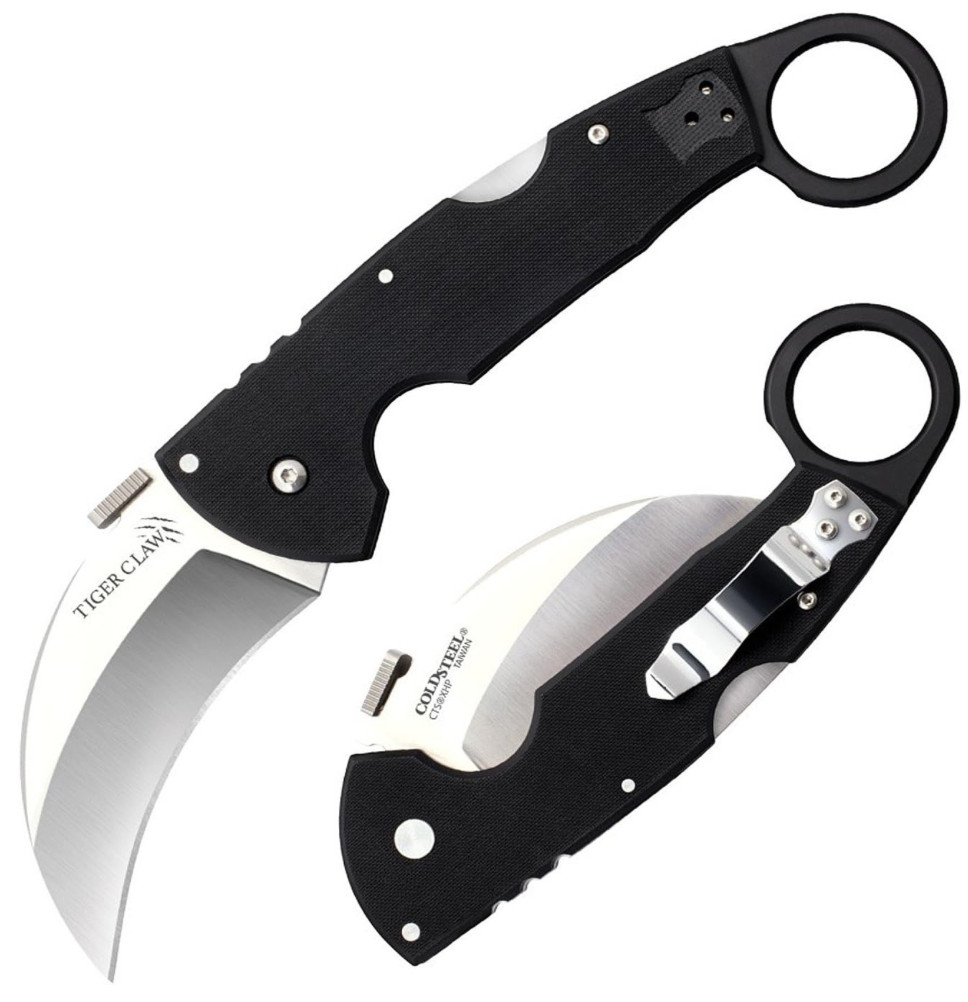
Designed by Andrew Demko, the Cold Steel Tiger Claw folding Karambit is designed to be a hybrid between a true Karambit and a working Hawkbill knife and thus, it is one of the few folding Karambits on the market that also makes a good every-day-carry folding knife. Featuring a closed length of 6 inches with a 3 inch blade and a weight of 5.1 ounces, it also features a Karambit style drop point blade design made from Carpenter CTS-HXP (which is one of the new “super” stainless blade steels) with an unknown Rockwell Hardness and is available with your choice of a plain edge or a fully serrated edge with a hollow grind and a satin finish. Plus, it also features a very ergonomic handle design with G10 handle scales and a thumb stud manual opening mechanism combined with Cold Steel’s Tri-Ad locking mechanism and a large pommel ring and, it includes a reversible, tip-up only, steel pocket clip.
Pros
- (+) Stainless “Super” blade steel
- (+) Will hold an edge very well
- (+) Single hand opening and closing
Cons
- (-) Excessively expensive
6. FOX KNIVES MODEL 479 FOLDING KARAMBIT
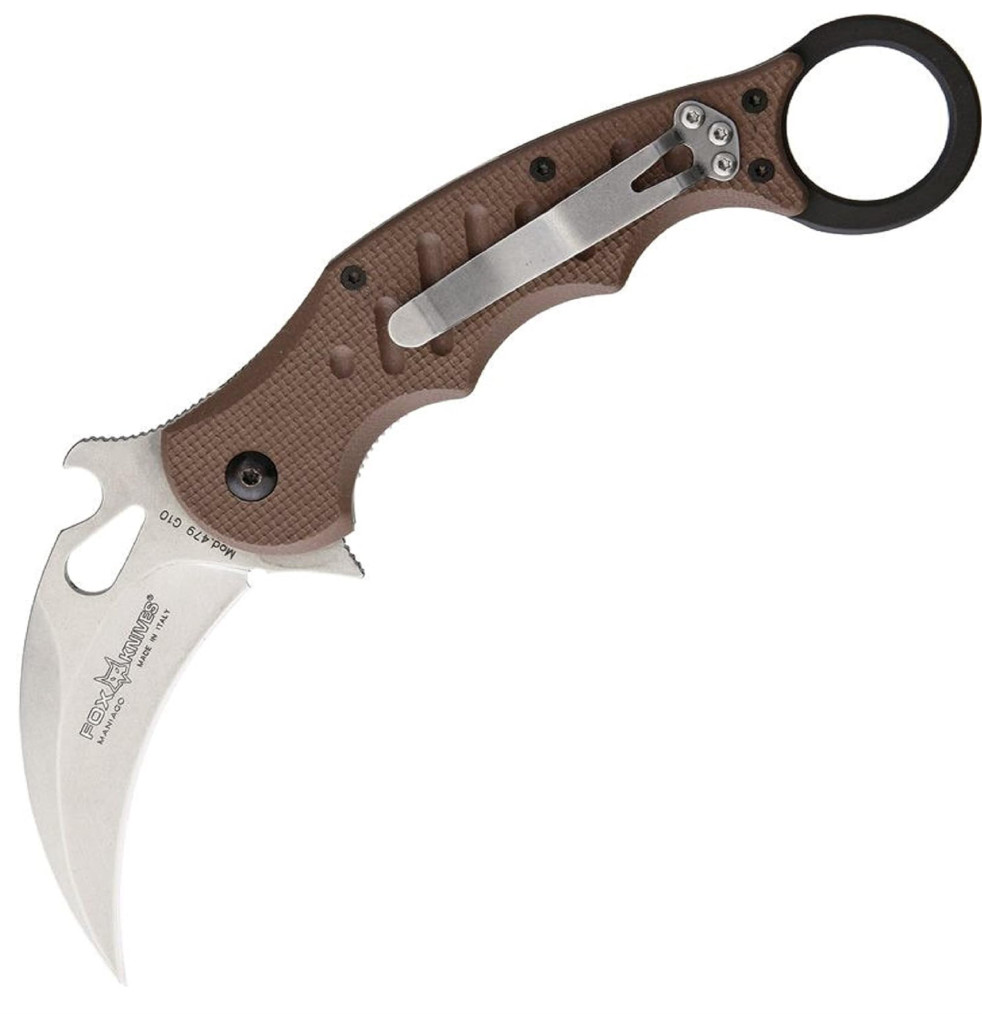
The Fox Knives Folding Karambit (model 479) features a closed length of 5.25 inches with a 3.2-inch blade and has a weight of 4.5 ounces. In addition, it also, it features a Karambit style drop point blade design made from N690 (which is an Austrian, high carbon, stainless steel) with an unknown Rockwell Hardness combined with a false edge and a plain edge with a hollow grind and a matte black finish. Plus, it also features very ergonomic handle design with textured G10 handle scales and a large pommel ring along with both a flipper and a thumb hole manual opening mechanism combined with a Liner Lock locking mechanism and, it includes a reversible, tip-up only, steel pocket clip.
Pros
- (+) Excellent choice of blade steel
- (+) One hand opening and closing
- (+) Thumb hole and flipper
Cons
- (-) Unknown Rockwell Hardness
7. S & W EXTREME OPS FOLDING KARAMBIT

Another folding Karambit that also serves as a useful everyday-carry utility knife, the Smith & Wesson Extreme Ops folding Karambit features a closed length of 5.38 inches with a 3-inch blade and has a weight of 6.1 ounces. In addition, it also, it features a Karambit style drop point blade design made from 7Cr17 (which is a Chinese, high carbon, stainless steel) with an unknown Rockwell Hardness combined with a single plain edge with a hollow grind and a bead blasted finish. Plus, it also features very ergonomic handle design with textured, black, G10 handle scales and a thumb stud manual opening mechanism along with a Liner Lock locking mechanism and a large pommel ring. Plus, it includes a right hand only, tip down only, steel pocket clip.
Pros
- (+) Good blade steel
- (+) Good every-day-carry design
- (+) One hand opening and closing
Cons
- (-) Marginal blade steel
- (-) Unknown Rockwell Hardness
CONCLUSION
So, remember that when choosing a Karambit, it is best to choose one made from high-quality blade steel so that it will be strong and hold an edge well and, when choosing a folding Karambit, it is best to choose one with a blade made from stainless steel so that it will resist corrosion. But, you should also keep the Rockwell Hardness in mind because it will provide you with a good relative guide to how hard a knife’s blade is and thus, how well it will withstand both lateral pressure and impact as well as how well it will hold an edge. Then, you need to give some thought to the length of the blade because blade length has a significant effect on both the feel of a fighting knife and the utility of an everyday-carry knife. Plus, in addition to blade length, you will also need to decide whether or not the added slicing and slashing power of a partially or fully serrated blade outweighs the difficulty of resharpening the serrations for you and, if so, then you will also need to find and purchase a round ceramic sharpening rod of the right diameter. Then, last but not least, if you choose to purchase a folding Karambit instead of a fixed blade Karambit, then you will also need to keep in mind that some opening and locking mechanisms force a user to employ two hands to open or close a blade while others enable a person to open or close a blade with a single hand. Or, you could save yourself all of that looking and instead choose one of the Karambits listed above since each one is well made, well designed, and well suited for its intended purpose!

